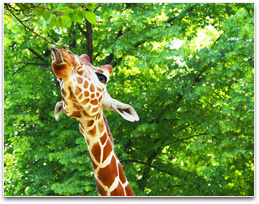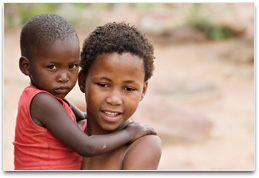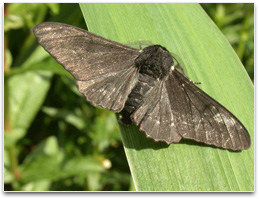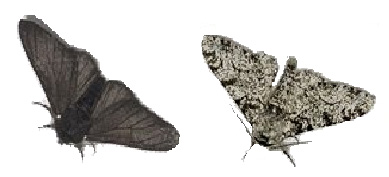This focus idea is explored through:
Contrasting student and scientific views
Student everyday experiences
 Many students believe that the physical characteristics of organisms change in response to changes in the environment in which the organisms live, and that these changes are passed on to future generations. For example, there is widespread belief that, over many generations, giraffes have gradually developed longer necks as they competed with other animals and each other to reach higher and higher leaves on trees for food.
Many students believe that the physical characteristics of organisms change in response to changes in the environment in which the organisms live, and that these changes are passed on to future generations. For example, there is widespread belief that, over many generations, giraffes have gradually developed longer necks as they competed with other animals and each other to reach higher and higher leaves on trees for food.
Many students also believe that organisms can deliberately develop new traits in order to improve their chances of survival. As an example, students believe that moths with spotted wings are able to change the colour and patterns on their wings so they are better camouflaged amongst tree trunks that may have become darker from pollution from industry. Many students also believe that repeated use of insecticides like DDT has meant present populations of insects have become resistant to these insecticides so they can survive.
Often students believe that changes in a population of a species come from gradual changes in all members of the population, rather than because of the survival of only a subset of that species that all share the traits that better assist in survival.
One important contributing factor to student confusion about these ideas is the everyday meaning of the word ‘adapt’ – in our everyday contexts, we use the word ‘adapt’ in ways that imply conscious and deliberate action (e.g. the arctic explorers adapted to the cold conditions).
Many students believe that if the surrounding environmental conditions change then organisms will ‘mutate’ in ways that will lead them to better survive the new conditions. For example, some students think that sickle-cell anaemia in Afro-Americans is a mutation that occurs because it provides that group with an advantage for survival in areas where malaria is prevalent, rather than acknowledging that it is already present in the gene pool of Afro-Americans.
Research: Woods-Robinson (1995), Brumby (1984)
Scientific view
In any given population there is genetic variation between individual organisms. Such variation usually results from changes that have occurred by chance and may be inherited by the organism’s offspring. These variations are known as mutations (see the focus idea
Genetic information is found in all living things - level 6). However, mutation alone does not account for the significant variation that is seen between individual organisms within a population.
The process of sexual reproduction generates significant variation in every generation through the recombination of genetic information located in chromosomes. (Note: This is different to asexual reproduction, for example in aphids, which result in offspring genetically identical to the parents; any variations in these populations are solely due to mutations).
Environmental conditions constantly change and this often encourages organisms to compete for limited resources such as food and shelter. Such competition reduces the number of organisms that actually survive the new conditions.
Individuals that can compete successfully are more likely to survive. In certain environmental conditions, individual organisms with particular characteristics (traits) are more likely than others without these traits to survive. They are also more likely to produce offspring who have also inherited these traits. Hence the proportion of the population of this organism with these advantageous traits increases. This idea underpins the concept of selection.
Selection is the main mechanism by which populations change or ‘evolve’ over a long period of time (typically thousands of years). The term ‘natural selection’ refers to the selection pressure placed on organisms as a result of conditions in their natural environment. Conversely, artificial selection refers to the human selection of traits considered particularly useful in an organism as practiced in animal and plant breeding programs e.g. selecting cows which produce milk with a high fat content for breeding. It is important to remember, however, that both forms of selection act on variation that is already present in the existing population.
An inherited characteristic that results in an individual surviving and reproducing is called an adaptation. For example, some moths (e.g. heliothis moths) are unaffected, or ‘resistant’ to, pyrethroid insecticides; when these types of insecticides are sprayed, these moths are not affected and therefore reproduce to give offspring who are also unaffected by these insecticides. This biochemical resistance to the insecticide is an adaptation of the pyrethroid resistant heliothis moth.
Not all traits create a survival advantage or disadvantage for later generations of the organism. For example, the human appendix does not appear to provide either a survival advantage or disadvantage to humans as our diets no longer contain high quantities of indigestible cellulose material.
Research: Griffiths et al (1993)
Critical teaching ideas
- Populations are made up of individual organisms whose traits (structural, behavioural, biochemical) show variation between individuals. Many of these variations are inherited.
- Individual organisms with certain traits are more likely than others without these traits to survive environmental changes, and therefore to have offspring; hence the proportion of the population of organisms with these advantageous traits increases. This represents the idea of selection.
- The inherited trait that allows an individual to survive and reproduce is called an adaptation.
- Some of these variations in traits between individuals may be advantageous while others may not be; the environment in which the population lives is a major determinant of advantage or disadvantage.
Explore the relationships between ideas about force and acceleration in the
Concept Development Maps – DNA and Inherited Characteristics and Variation in Inherited Characteristics.
Teaching activities
A problem for teaching in this area is that students’ existing ideas about natural selection cannot be easily tested as it takes considerable time for most complex organisms to reproduce with sufficient generations to see any effects of either natural or artificial selection.
Although it is not difficult to get classroom debate going about issues such as whether or not acquired characteristics can be passed on to successive generations, it is inevitable that at some point the teacher will have to introduce and consolidate some key genetic principles as outlined in the critical teaching ideas above.
Bring out students’ existing ideas
Selection is the term used for the ‘survival of the fittest’ and occurs when some individuals with favourable characteristics have a greater chance than others of leaving fertile offspring. If this occurs naturally it is known as natural selection and if it is controlled, such as in breeding animals for particular purposes, it is known as artificial selection.
Encourage students to work in small groups to explain (with drawings) what they think the term ‘survival of the fittest’ means. How might the term mean different things in terms of natural and artificial selection? These group ideas can then be presented back to the whole class for further discussion to compare each group’s definitions of this term with the accepted scientific view.
Challenge some existing ideas
 An inherited characteristic that allows an individual organism to survive and reproduce (either sexually or asexually) is called an adaptation. Ask students to think about the characteristic of skin colour. In the tropics, a darker skin colour is an advantage as it helps to reduce sunburn and tissue damage.
An inherited characteristic that allows an individual organism to survive and reproduce (either sexually or asexually) is called an adaptation. Ask students to think about the characteristic of skin colour. In the tropics, a darker skin colour is an advantage as it helps to reduce sunburn and tissue damage.
In less sunny climates, such as is experienced in regions closer to the poles, a paler skin is an advantage as there is more exposure to ultraviolet radiation (a component of sunlight) which assists the body to synthesise Vitamin D. However, in Australia, skin colour tends not to be considered in terms of limiting exposure to the sun.
Encourage students to consider if the characteristic of skin colour is an adaptation and what influence the environment may have on such adaptations.
Practice using and building the perceived usefulness of scientific models
The Case of the Peppered Moth
 There are two types of peppered moth (Biston betularia) which can be identified by their wing colour. One type has a light coloured wing, while the other, the most common, has a dark colour wing.
There are two types of peppered moth (Biston betularia) which can be identified by their wing colour. One type has a light coloured wing, while the other, the most common, has a dark colour wing.
The Industrial Revolution began in England late in the 18th Century. Before the Industrial Revolution the light colour moth was the only type of moth observed; it is not known if the dark colour moth existed at this time. By 1850 there were many industrial sources of pollution, particularly high levels of sulphur dioxide and smoke.
Between 1850 and 1950, the numbers of dark colour moths observed increased in these industrial areas, but these numbers decreased as one moved away from the industrial areas. Then, with the introduction of clean-air laws in England, the levels of air pollutants have more recently
decreased and the numbers of light coloured moths are once again
increasing.
It is known that these moths rest in the canopy of trees on the underside of branches and twigs in unexposed position in shadows.
Ask the class to discuss in small groups how the ideas of mutation and natural selection could be used to explain the different numbers of light and dark coloured moths at different times in history. How might you test these ideas? See image of dark and light peppered moths (Biston betularia).

Fig 1. Dark and light peppered moths (Biston betularia)
The Effect of the Myxoma Virus on the Rabbit Population of Australia
As an extension of the moth activity above, students could explore the effects of the myxoma virus on the rabbit population in Australia.
In 1950, the myxoma virus was introduced into Australia to combat the serious economic and environmental impact of the enormous population of European rabbits after their initial introduction. The rabbit numbers had continued to increase due to the ready availability of feed and the absence of any native Australian predators.
The initial introduction of the virus proved incredibly successful, killing over 98% of the rabbits it infected after just a few days. However as time has passed the virus has gradually become less effective in controlling the numbers of rabbits.
Both the rabbit and the virus have continued to evolve, and the virus has now quite reduced effectiveness.
See the following page on the
CSIRO website for additional background: